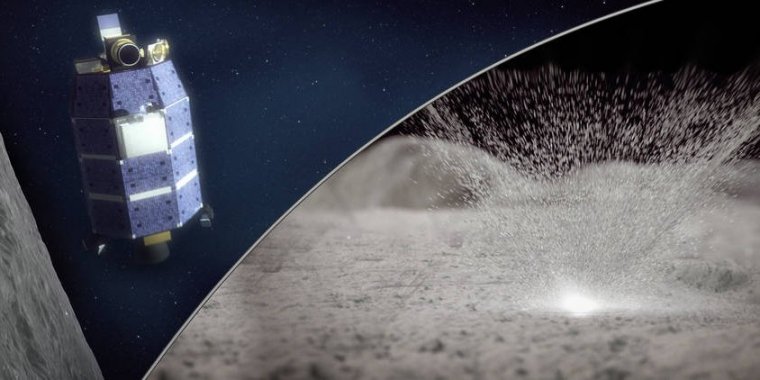| News / Space News |
Meteoroid Strikes Eject Precious Water From Moon
Researchers from NASA and the Johns Hopkins University Applied Physics Laboratory in Laurel, Maryland, report that streams of meteoroids striking the Moon infuse the thin lunar atmosphere with a short-lived water vapor.

Artist’s concept of the LADEE spacecraft (left) detecting water vapor from meteoroid impacts on the Moon (right). Photo: NASA/Goddard/Conceptual Image Lab
The findings will help scientists understand the history of lunar water — a potential resource for sustaining long term operations on the Moon and human exploration of deep space. Models had predicted that meteoroid impacts could release water from the Moon as a vapor, but scientists hadn’t yet observed the phenomenon.
Now, the team has found dozens of these events in data collected by NASA’s Lunar Atmosphere and Dust Environment Explorer. LADEE was a robotic mission that orbited the Moon to gather detailed information about the structure and composition of the thin lunar atmosphere, and determine whether dust is lofted into the lunar sky.
There’s evidence that the Moon has water (H2O) and hydroxyl (OH), a more reactive relative of H2O. But debates continue about the origins of the water, whether it is widely distributed and how much might be present.
The Moon doesn’t have significant amounts of H2O or OH in its atmosphere most of the time. But when the Moon passed through one of these meteoroid streams, enough vapor was ejected for us to detect it. And then, when the event was over, the H2O or OH went away.
To release water, the meteoroids had to penetrate at least 3 inches (8 centimeters) below the surface. Underneath this bone-dry top layer lies a thin transition layer, then a hydrated layer, where water molecules likely stick to bits of soil and rock, called regolith.
From the measurements of water in the exosphere, the researchers calculated that the hydrated layer has a water concentration of about 200 to 500 parts per million, or about 0.02 to 0.05 percent by weight.
This concentration is much drier than the driest terrestrial soil, and is consistent with earlier studies. It is so dry that one would need to process more than a metric ton of regolith in order to collect 16 ounces of water.
Because the material on the lunar surface is fluffy, even a meteoroid that’s a fraction of an inch (5 millimeters) across can penetrate far enough to release a puff of vapor. With each impact, a small shock wave fans out and ejects water from the surrounding area.
When a stream of meteoroids rains down on the lunar surface, the liberated water will enter the exosphere and spread through it. About two-thirds of that vapor escapes into space, but about one-third lands back on the surface of the Moon.
These findings could help explain the deposits of ice in cold traps in the dark reaches of craters near the poles. Most of the known water on the Moon is located in cold traps, where temperatures are so low that water vapor and other volatiles that encounter the surface will remain stable for a very long time, perhaps up to several billion years.
Meteoroid strikes can transport water both into and out of cold traps. (NASA)
YOU MAY ALSO LIKE



